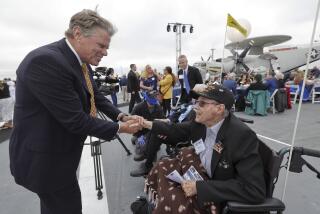Delford Smith dies at 84; aviation entrepreneur bought ‘Spruce Goose’
- Share via
Delford Smith, a rags-to-riches entrepreneur who reportedly bought his mother a home when he was 11, founded a worldwide aviation business and later purchased Howard Hughes’ ”Spruce Goose” for a museum he built in McMinnville, Ore., has died. He was 84.
Smith died at home Friday of natural causes, said Andrew Anderson, a funeral director in McMinnville.
Smith’s Evergreen International Airlines filed for bankruptcy last December. His Evergreen Aviation and Space Museum remains open, with Hughes’ colossal wooden plane a centerpiece that draws as many as 150,000 visitors a year.
Flown only once — and then just for a minute in 1947 — the Spruce Goose was hidden from public view for decades. Though it was conceived by industrialist Henry J. Kaiser as the biggest-ever military transport plane, Hughes designed and built the over-budget, long-delayed, widely derided behemoth. By 1992, when Smith and his son Michael King Smith acquired it, the Spruce Goose was a struggling Disney attraction next to the Queen Mary in Long Beach.
The Smiths had the massive plane disassembled and loaded into dozens of trucks for the move north. The wings, fuselage and tail were shipped up the West Coast by barge — a process avidly followed throughout Oregon, where the plane, six times larger than others of its day, became a quirky source of local pride.
“The Hughes Flying Boat is resting safely in Oregon, home of the beaver, the ducks and the goose,” callers to a hotline were assured after the barge had navigated the Columbia and Willamette rivers.
When Michael King Smith was killed in a 1995 car crash, his father poured himself into his son’s museum idea and “built it dramatically larger than it probably would have been otherwise,” museum director Larry A. Wood said in an interview Sunday.
A hard-charging businessman, Delford Smith founded a helicopter and air cargo service that operated in 168 countries.
Smith’s aircraft fought Kuwaiti oil field fires after the Gulf War, combated tsetse flies in Africa, delivered food to refugees from Kosovo, destroyed opium poppies in Mexico and Peru, performed more than 200 logistical missions for U.S. forces in Afghanistan and shuttled personnel to “every oil patch in the free world,” according to a company video.
“We were operating all over the world, so we were close to every urgent need that came about,” Smith once told an interviewer.
Born in Seattle on Feb. 25, 1930, Delford Michael Smith was adopted from an orphanage when he was 2. Raised by an ailing woman who cleaned houses and worked in a candy factory, Smith delivered newspapers, sold lumps of coal he scrounged off railroad tracks and did farm labor in the summer.
When he was 7 and wanted to mow lawns, his mother encouraged him to borrow $2.50 from the local bank.
“I borrowed from a second bank, paid the first one off, then paid the second one,” he said in accepting a 2002 honor from the Horatio Alger Assn. “I got started with credit at an early age.”
By the time he was 11, he said in interviews, he had saved enough for the initial payment on a family home. The equity in that house helped him pay his way through the University of Washington, he said.
After graduating in 1953, Smith served in the Air Force and started a helicopter service in 1960. In the late 1970s, he acquired passenger planes and was offering charter tours. Over the years, he also worked on more exotic missions. In 1980, one of his planes ferried the deposed Shah of Iran from Panama to a refuge in Egypt.
The company folded last year. Industry analysts blamed its demise on high levels of debt and lower revenue from military work.
Smith’s survivors include his wife Maria and son Mark.
Across the road from his shuttered company, the Evergreen museum displays dozens of vintage aircraft. The Goose, made mostly out of birch, is the most famous. Its only flight — one mile at 70 feet over Long Beach Harbor — was on Nov. 2, 1947, two years after the end of the war effort it was meant to aid. Hughes was at the controls.
The museum complex includes an indoor water park.
When Smith described his idea for it to associates, someone asked what would make it distinctive.
“He said, ‘Let’s put a plane on the roof!’ and the whole room laughed,” Wood recalled.
But Smith didn’t laugh: “Let’s make it a 747,” he said.
Opened in 2011, the Evergreen Wings & Waves water park has a 747 on the roof.
Twitter: @schawkins
More to Read
Start your day right
Sign up for Essential California for the L.A. Times biggest news, features and recommendations in your inbox six days a week.
You may occasionally receive promotional content from the Los Angeles Times.







